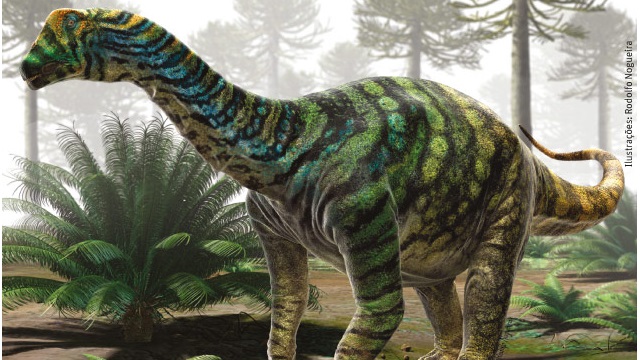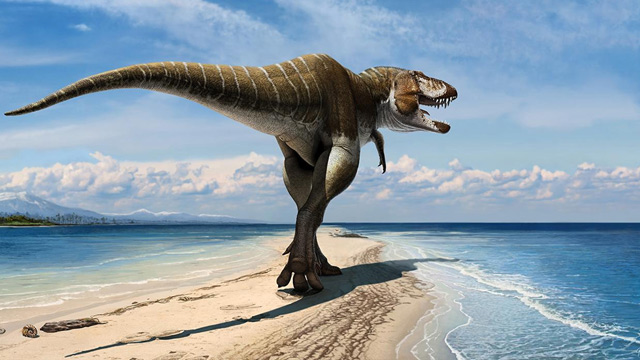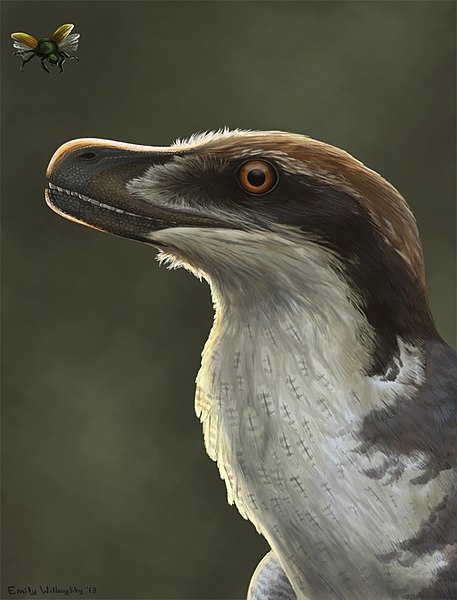Welcome back everyone! I hope that everyone had a good Christmas! I know I did. There were no movie updates this week, so we'll jump write into this week's topic right after we look at our "days till" section.
It is: 6 days till New Year's!
Despite the fact that most people only have heard of a select few dinosaurs (e.g. T. rex, Triceratops, Stegosaurus), scientists have discovered hundreds and hundreds of different dinosaur species, many of which have only been discovered in the last ten years! Take a look at this clip from the new movie, Walking with Dinosaurs: The 3D Movie to see what I mean:
It is: 6 days till New Year's!
Despite the fact that most people only have heard of a select few dinosaurs (e.g. T. rex, Triceratops, Stegosaurus), scientists have discovered hundreds and hundreds of different dinosaur species, many of which have only been discovered in the last ten years! Take a look at this clip from the new movie, Walking with Dinosaurs: The 3D Movie to see what I mean:
So as
you can see, dinosaurs are being discovered all the time. Before we
go on, you should know that even though there appear to be hundreds
and hundreds (perhaps thousands) of different species of dinosaurs
Some
even have only made their appearance within the past year! Some
dinosaur discoveries consist of a few unidentifiable bones and are
put in museum storerooms until they can be identified. But there are
many others that consist of terrific skeletons. Like the article I
posted about dinosaurs discovered in the last few years,
I'll give a little description of the dinosaur itself. Let's start
learning about some of the newest discovered dinosaurs that used to
roam the world before the Flood of Noah's time killed and buried
these amazing animals that can only be seen as fossils today:
Acheroraptor
Discovered
in the Hell Creek Formation in Montana, Acheroraptor
means “underworld thief” and was discovered and named by David C.
Evans, Derek W. Lawson and Philip J. Currie. As the last part of its
name suggests, Acheroraptor
is a dromaeosaur or “raptor” dinosaur and related to the more
famous Velociraptor.
Like Velociraptor,
Acheroraptor had a
sickle-shaped claw on each foot that was used to help kill its prey.
Albertadromeus
 |
| Image Credits |
The
small ornithopod Albertadromeus
was an herbivorous creature from Alberta, Canada, hence its name
which means “Albertan runner”. Like its name suggests, this
dinosaur was a swift and agile runner; this is a good thing because
when this animal was alive, predators such as Daspletosaurus,
Troodon,
Saurornitholestes and
Dromaeosaurus would
have stalked the landscape Albertadromeus
made home. Other dinosaurs that lived with this relatively small
dinosaur were Coronosaurus,
Anchiceratops,
Chasmosaurus,
Parasaurolophus and
Corythosaurus among
others.
Brasilotitan
 |
| Image Credits |
Brasilotitan
was a genus of titanosaur sauropod from the Cretaceous habitat of the
pre-Flood world. Sauropods – more commonly known as “long-necked
dinosaurs” – were the largest land animals God made and are found
on every continent. As its name suggests, Brasilotitan
was discovered in Brazil. It was closely related to sauropods such as
Antarctosaurus (which
was discovered in southern South America! Go figure!) and
Bonitasaura.
Cuspicephalus
Though
discovered in 2009, Cuspicephalus
wasn't named until 2013. This animal was a pterosaur, not a dinosaur,
as dinosaurs were terrestrial creatures. The exact size of the animal
is not yet determined due to the incompleteness of the fossils found
so far, but its skull is about 326 millimeters long and 55
millimeters high. Like many pterosaurs, Cuspicephalus
had a crest on its head, probably used for display.
Jiangxisaurus
Jiangxisaurus
was a species of oviraptorid theropod from the Cretaceous of China.
It is quite similar to its relative Oviraptor.
The family Jiangxisaurus
belongs to is also known for their head crests that, like the head
crest of Cuspicephalus,
were probably used for display purposes.
Judiceratops
 |
| Image Credits |
Judiceratops
is a relative of the more famous Triceratops.
Like Triceratops,
Judiceratops possesses
a large neck frill and three horns on its head for protection and
display. It was discovered in the Judith River Formation in Montana.
Lythronax
 |
| Image Credits |
Lythronax
was a ferocious 24-foot, 2.5 ton carnivore from Utah and since many
of its more “important” parts of its skeleton were well
preserved, we tell know a good bit about this extinct reptile. It
that had a short, narrow snout and eyes set far back on its head. Its
forward facing eyes enabled it to see three-dimensionally, which
helped it lock its target on what it hoped to catch for a meal. And
when Lythronax bit
down, there was no way of the prey getting loose from its toothy
grip! Lythronax was an
efficient hunter that would have hunted a variety of herbivorous
dinosaurs such as members of the ceratopsian (horned dinosaur) and
hadrosaur (duck-billed dinosaurs) family. Like its larger cousin, T.
rex, this dinosaur had large banana-shaped, serrated teeth that were
perfect, not for slicing, but for chomping out huge chunks of meat
and bones. That makes it no wonder it's name means “king of gore”!
Nasutoceratops
 |
| Image Credits |
Siats
 |
| Image Credits |
Yet
another dinosaur from the state I live in, Siats,
at around 30-40 feet long and weighing 2.5 tons, is the third largest
carnivorous dinosaur from North America, behind Acrocanthosaurus
and, of course, Tyrannosaurus rex.
This dinosaur is related a carnosaur and is related to creatures such
as Allosaurus and the
aforementioned Acrocanthosaurus,
two dinosaurs whose remains are also found in Utah.
Xinjiangtitan
Many
species of sauropods grew to gigantic proportions, and Xinjiangtitan
was definitely no
exception – it grew 98-105 feet long, outsizing most other
sauropods. The only sauropods that grew longer were creatures
including Diplodocus
and Argentinosaurus.
Like its relatives, this dinosaur was herbivorous, stripping plants
of their leaves and/or fronds with its spoon-like teeth. As its name
suggests, this dinosaur is from China.
So there you have it, a list mentioning a mere few of the incredible
(and often times bizarre) dinosaurs discovered in 2013. I hope you've
enjoyed the articles my co-author, Joy, and I have written as much as
we enjoyed writing them. Next week begins a new year! The year 2014
will be upon us! I'm also planning to do things slightly different
with the set-up of this website, so be sure to come back next week to
see what changes are made. Happy New Years everyone!
PS 1: To post a comment
(this is highly encouraged), please simply click the post you wish to
comment on, scroll to the bottom of the page and put what you wish to
say or ask in the comment box. Then in the box below the comment box
choose who you’re going to comment as. And then click preview
or publish. If you aren’t signed into Google, you’ll be
asked to type in a word and a number in the space provided. Type the
word, put a space and then put the number. Then your comment is on
the blog!
PS 2: Have a puzzling question about
animals (including dinosaurs), myself, my latest book, my stop-motion
movies, Creation or etc? Please post your question as a comment or
send me an email at animaladventures@aol.com.
PS 3: What’s the new in the news?
Check it out at SMILEY’S
NEWS.
PS 4: Be sure to comment on the latest
stop-motion movies too, this will help me improve them.



.jpg/800px-Xinjiangtitan_(adjusted).jpg)
No comments:
Post a Comment